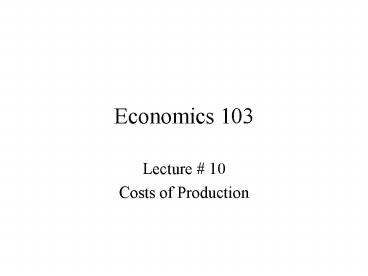Economics 103 - PowerPoint PPT Presentation
Title:
Economics 103
Description:
Economics 103 Lecture # 10 Costs of Production When we introduce the idea of Comparative Advantage, we re talking about different people or different inputs having ... – PowerPoint PPT presentation
Number of Views:35
Avg rating:3.0/5.0
Title: Economics 103
1
Economics 103
- Lecture 10
- Costs of Production
2
When we introduce the idea of Comparative
Advantage, were talking about different people
or different inputs having different costs.
Now we want to look at a different situation the
same input may experience different costs when
used in different proportions with other inputs.
We start with the idea of a production function
3
The production function embodies the best
technology.
It gives you the most output for a given input.
What will your dog do?
4
For the moment this function describes the
firm.
(2L, 2K)
2Q
(3L,3K)
3Q
But we are not going to worry about returns to
scale, we will focus in on changes in
proportions.
That is, changing the L/K ratio.
5
Lets assume that K is fixed. Then changes in L
will change the L/K ratio.
Lets also define the Marginal Product of Labor
as ?Q/?L
Well define the Average Product of Labor as
Q/L
6
Well also assume the production function has
three stages when the L/K ratio changes.
This three stage function includes our 5th
principle.
7
In stage 1 we have
In stage 3 we have
8
But in Stage 2 we have what is relevant.
Now lets go back to the graph.
9
What section shows diminishing MP?
What is happening to AP over these three stages?
What is the use of a marginal product curve?
10
A marginal product curve (in stage 2) is actually
the demand for labor ... When you multiply by
the price of the output.
Demand for labor.
The equilibrium amount of labor hired is where
the price equals the value of the marginal
product.
11
Even if youre the best darn rock picker in the
world, why might your wage be low?
12
When there is more than one variable input, it
still holds that the demand for labor equals
the value of the marginal product.
So, suppose both capital and labor are variable.
Then we have the following equilibrium.
Now the equilibrium conditions are w
pMPL v pMPK
13
If we have w pMPL v
pMPK Then we get
14
Equating marginal products is what lies behind
Triage
In an emergency you first help the ones who are
at the margin.
15
In Oregon, the state health insurance will not
pay for care that I) is extremely expensive,
or II) has no proven benefit.
Again, this equates the marginal product per
dollar.
Should the government devote research money to
finding cures for extremely rare diseases?
16
The most effective naval weapon in the Second
World War was
90 of enemy shipping was destroyed by subs.
But then why have battleships?
17
Moneyball.
18
So at the margin, the first battleship was more
productive than the 1000th submarine.
This explains why we dont see a hockey team made
up of
19
Back to Marginal Products
Marginal Products and Marginal Costs are
inversely related.
What is the intuition behind this?
20
So now we have two reasons for why MC curves are
increasing.
- As output increases, different inputs are used.
At first the - low cost inputs are used, then the high
cost inputs are used. - That is, there is an extensive adjustment.
2. As output increases, each input is used more
intensively relative to the amount of
capital. This lowers the inputs marginal
product, and increases the marginal cost. This is
an intensive adjustment.
21
Aside from Marginal Costs, there are three other
types of costs we need to worry about.
1. Average Fixed/Sunk costs AFC FC / Q.
Divide by Q
Total cost fixed costs variable costs.
ATC AFC AVC.
22
If we have the three stage production function,
then these cost curves look as follows
Why would they be this shape?
Where would the Marginal Cost curve fit in
here?
23
What would happen to the cost curves if you put
on a a. tax per unit of output? b. a lump
sum tax?
What would happen to the cost curves if
a. labor became more productive? b. wages
increased?































